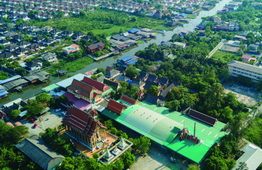Typologies of Waterfront Verandas: Edging Place and Connections
Main Article Content
Abstract
This research aims to build an architectural typology of waterfront-dwelling verandas, a defining habitat for many communities living along the rivers of Thailand. The waterfront veranda is, in this paper, considered as an in-between space, a place at the edge of two spheres, a place that separates but also connects, and also a place of transition. Verandas in Thai traditional dwellings are considered as essential elements of the domestic space, encapsulating the lifestyle of their residents and their connection to the neighboring environment. Yet, despite their outstanding features and their significance for communities, they have not received much attention from heritage practitioners and architectural historians. This paper builds this typology on the basis of nine case studies of waterfront dwellings surveyed along the Om-Non Canal, Nonthaburi Province. The survey offered the author of this paper an opportunity to explore spatial relation schemes, conduct observations on environmental behavior, and also interviews.
Survey findings show four emergent types of waterfront verandas: (1) pavilion type; (2) veranda type; (3) veranda-plus-pavilion type; and (4) gallery type, all of which approximately take up between 20-25% of the total ground floor area of the dwellings surveyed. On the one hand, each type surveyed features a distinctive spatial arrangement which testifies to the relationship between the waterfront dwelling and the neighboring waterway and the boundary between the two spheres. On the other hand, all waterfront verandas share this common feature as an in-between and edging place in terms of semi-open transition and offer spatial flexibility for mixed use functionalities and social space for informal interactions with other residents of waterfront communities.
In conclusion, waterfront verandas encapsulate the sense of identity of waterfront communities even if water transportation among these communities has seen its role decline significantly. As new suburban residential developments encroach on these traditional waterfront neighborhoods without any connection to their immediate environment, understanding of this typology of waterfront verandas may offer alternatives for meaningful redevelopment of waterfront neighborhoods and contribute to reconcile the needs for preserving the cultural identity of waterfront communities with the pressure of future property developments.
Downloads
Article Details

This work is licensed under a Creative Commons Attribution-NonCommercial-NoDerivatives 4.0 International License.
References
Chot Kanlayanamit. Sathāpattayakam bǣp Thai dœ̄m [Traditional Thai Architecture]. 2nd ed. Bangkok: The Association of Siamese Architects under Royal Patronage, 1996.
Gehl, Jan. Cities for People. Washington: Island Press, 2010.
Janson, Alban and Tigges, Florian. Fundamental Concepts of Architecture: The Vocabulary of Spatial Situations. Basel: Birkhauser, 2014.
Kleinsasser, William. Synthesis 9: A Theory Base for Architecture, Course Manuscript. Eugene: University of Oregon, 1999.
Lincoln, Yvonna and Guba, Egon. Naturalistic Inquiry. California: Sage Publications, 1985.
Narongpon Laiprakobsup. “Drawing Embodied Spatial Networks in Parallel with Sustainability of Place.” Journal of Architectural/Planning Research and Studies 7, 1 (2010): 29-42.
Narongpon Laiprakobsup. Inbetween Place: The Emergence of the Essence. Germany: VDM Verlag Dr. Muller, 2008.
Narongpon Laiprakobsup. “Inbetween Place: The Presence of Transitional Intervals.” Journal of the Faculty of Architecture, Silpakorn University 23 (2008): 17-38.
Onsiri Panin. Thī wāng thāng sathāpattayakam [Space in Architectue]. Bangkok: Rangsit University Press, 1995.
Phopsuk Tadtong. “Khwāmmāi khō̜ng phư̄nthī chān nai ngān sathāpattayakam bānphak ʻāsai Thai rūamsamai [Meaning of chan (central terrace) in contemporary Thai house].” Ph.D. dissertation, Silpakorn University, 2020.
Rossi, Aldo. The Architecture of the City. Cambridge: The MIT Press, 1982.
Ruethai Jaijongrak. Rư̄an Thai dœ̄m [Traditional Thai House]. 2nd ed. Bangkok: The Association of Siamese Architects under Royal Patronage, 1996.
Sumet Jumsai na Ayudhya. Nam: bō̜kœ̄t hǣng watthanatham Thai [Water: The Origin of Thai Culture]. 2nd ed. Bangkok: The Association of Siamese Architects under Royal Patronage, 1996.
Van Eyck, Aldo. Team 10 Primer. Edited by Alison Smithson. Cambridge: MIT Press, 1968.
Vimolsiddhi Horayangkura, Kobkul Intharawichit, Santi Chantawilatwong and Vira Inpuntung. Phatthanākān nǣo khwāmkhit læ rūpbǣp khō̜ng ngān sathāpattayakam ʻadīt patčhuban læ ʻanākhot [Development of Concept and Architectural Style: Past, Present and Future]. Bangkok: The Association of Siamese Architects under Royal Patronage, 1993.
Yin, Robert. Case Study Research: Design and Method. 2nd ed. Thousand Oaks: Sage Publications, 1994.


